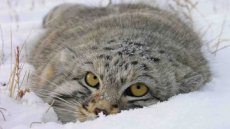|
|
|
|
|
The largest manul cat population in Russia lives in Tuva |
|
23 August 2012 | 5065 views | 0 comments |
|
|
 In Russia, the numbers of the manul wild cat, which is a rare species and is in the Red Book, are the highest in Tuva . This is due to a number of factors, one of them is the fact that there are few serious threats to the cat in this region, as the co-ordinator of the Siberian ecologic center in Novosibirsk, Anna Barashkova, informed RIA Novosti. In Russia, the numbers of the manul wild cat, which is a rare species and is in the Red Book, are the highest in Tuva . This is due to a number of factors, one of them is the fact that there are few serious threats to the cat in this region, as the co-ordinator of the Siberian ecologic center in Novosibirsk, Anna Barashkova, informed RIA Novosti.
Manul is a rare predator of the steppe and semi-steppe zones of Eurasia, and is listed in both the international and Russian red Books. This wild cat has a status that is close to threatened. According to scientists' data, the numbers of the animals are decreasing. Besides, the animals are threatened by poachers, and there is danger of shrinking habitat. Russia is home to the northernmost range of this species; manul is seen most often in in mountain-steppe and desert-steppe landscapes south-east of Republic Altai, in republics Tuva, Buryatia, as well as in the south-east part of Trans-Baikal region.
To count the cats
"In Russia, manul is at the periphery of its range…The central and largest fragment of the Russian range of the manul is located in Tuva. The numbers of manul in this republic have always been relatively high, and the area of the suitable habitat is large. However, evidence about its numbers and spread in republic Tyva have lately been scarce… Last year we managed to substantially increase new data about the numbers and spread of manul in Tuva, to fill in the database of the Sib-eco-center. This should serve to improve the monitoring and protection of the manul in the republic," - Barashkova stated.
Specialists carried out a census in a number of Tuvan districts. The eastern parts of Central-Tuvan and Ubsunur depressions, and the north of Turan-Uyuk depression. Beside search for footprints and other evidence of life activities of the wild cat, the scientists also questioned the local population, including sheep-herders and state inspectors from the Preserve. Questioning and search for evidence were also carried out at cattle-herding stations of the Mongun-Taiga mountain cluster. As a result, the scientists created a map of manul habitat range in Tuva, with separation into biotopes (different types of places).
"The results of this research confirm that Tuva really is an important region of manul range. The density of evidence of footprints from the winter census averages 2.6 prints per 10 square kilometers (maximum - 5.0 on steep stony slopes). This is about 1.5 to twice that of the indices which we obtained before for South-East Altai," - Barashkova informed us.
Earlier, she informed the agency that in South-east part of Gorniy Altai, according to their evaluation, there are at least 350-400 manuls.
A lot of food and few threats
According to Barashkova's data, it is the presence of Daur prairie dog, mountain voles, and other social rodents, that is important as prey for the manul. In Tuva, the manul chooses slopes of valleys between mountains for their habitat, as well as smaller hills within these valleys; it is also attracted to mountainous zones of Mongun-Taiga system. The total area of such territories in the region, according to the scientists' evaluation, is about 37 thousand square kilometers. However, because of biological features and the presence of their food-base, the manul populates this territory unevenly.
"Based on the evidence of the questioning, data of the census and materials from other studies, we determined seven key areas of manul habitat. This is the right bank of Ulug-Khem river, hills and left bank of Kaa-Khem, macro-slopes of Eastern Tannu-Ola and Western Tannu-Ola, sands and left bank of river Tes-Khem, granite outcroppings at left bank of Tes-Khem and the Mongun-Taiga mountain system," - she explained.
The expert added that on the whole currently Tuva remains one of the regions where there are few dangers to the manul. Among the chief dangers for this animal, Barashkova mentioned attacks by sheepdogs, (about 20% of those questioned informed the researchers about incidents of manuls killed by dogs), and agricultural use of the territory.
"Main dangers are associated with the commencing construction work of the Kyzyl-Kuragino railway, development of mining industries and tourism complexes. Currently there are few large territory development projects , and they involve the manul habitat only marginally," - she believes.
There is another name for the manul - Pallas's cat. The species received the name in honor of German naturalist Peter Pallas, who discovered the manul on the shores of the Caspian Sea in 18th century. There is a hypothesis that it is related to Persian cats, who resemble the manul in their fluffy fur, rounded form and head shape, which is quite unusual for other cat breeds. The ends of the thick grey fur are white, which makes the manul look as if it was sprinkled with snow. It has a more robust body build than its domestic relatives. The manul weight about 5 kilograms. The paws are thicker and shorter.
|
|
|
|
|
|
RIA Novosti, translated by Heda Jindrak |
|
|
|
|
|
|
| Notice |
|
|
|
|
New comments for news item are allowed for 365 days after publication.
|
|
|
|
|
|
|
|
|
|
|
